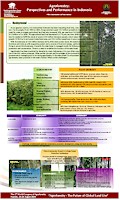| Poster |
 |
|
| Title | Agroforestry: Perspectives and Performance in Indonesia | | Author | Niken Sakuntaladewi and Iman Santoso | | Year | 2009 | | Publisher | World Agroforestry Centre - ICRAF, SEA Regional Office | | City | Bogor, Indonesia | | Call Number | PO0211-09 | | Notes | The 2 World Congress of Agroforestry Nairobi, 24-28 August 2009 |
|
| Abstract: |
| As an agrarian country, it is ironical that Indonesia has been importing food (rice, corn, wheat, beans etc.) for its people. From 1996 to 2005, the government spent 14.7 trillion annually to import food. The 3 need for water to irrigate agricultural land had also increased 10% per year from 74.9 billion m in 1990 to 3 91.5 billion m in 2000. The agricultural land had decreased 0,17 % per year from 2000 to 2005. More land is needed to fulfill the needs of around 220 million Indonesia people, whom about 48.8 million people (12%) live in and around state forest area, and 10.2 million people are in poor economic condition. With the total area of 120 million hectares (62% of the total country land), this state forest has important functions and roles as a life supporting system and a sources of food and energy, particularly for the people living in around the forest area. Currently the state forest is managed mostly for timber production, protection and conservation. There is a need to re-define the function of the state forest. Agroforestry has been practiced for decades by many Indonesians. It is one of the ways in optimizing the use of land for various purposes. What are the concern and knowledge of the community and the government in managing and in involving agroforestry in the state forest? To what extent has the agroforestry been practiced in the state's forests? What are the challenges? |
|
|
Download file(s): Click icon to download/open file.
|
| |
File Size |
Description |

|
922 KB |
Softcopy |
|
|
GRP 6: Developing policies and incentives for multifunctional landscapes with trees that provide environmental services
|
| Viewed in 2264 times. Downloaded in 473 times. |